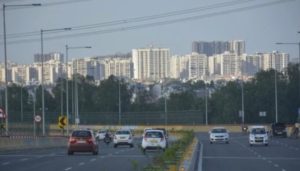
The National Capital Region Planning Board (NCRPB) has proposed several measures in the draft Regional Plan-2041 for sustainable development of the region, including limiting the National Capital Region (NCR) to a 100km radius from Rajghat in Delhi, and the reduction of travel time between NCR cities to 30 minutes.
Read all the latest updates on COVID-19 here.
The NCRPB has invited public comments on the draft plan until January 7.
The NCR, which includes Delhi and 24 districts from Haryana, Uttar Pradesh, and Rajasthan, is spread over 55,083sqkm. Its size has increased by almost 20,000sqkm since 2005. The present NCR, according to the Regional Plan-2041, is bigger than states such as Punjab, Uttarakhand, Kerala, and Sikkim.
The latest document notes that despite two long-term regional plans there has been haphazard growth in the NCR.
Delineation of NCR
There is a need for a compact area to ensure planned development of the region, a senior official of the planning board who asked not to be named said.
In October, the NCRBP in-principle approved a proposal to limit the NCR to a 100km radius from Rajghat in Delhi. ‘Beyond the 100km radius and up to the existing NCR boundary, all notified cities/ towns along with a corridor of 1km on either side of connecting expressways/national highways/state highways/the Regional Rapid Transit System will be included,’ the official said.
While the delineation exercise is still going on, the NCRBP said the redefined boundaries will come into effect after being notified by the Union ministry of housing and urban affairs.
According to the regional plan, there will be no change in the number of areas from Uttar Pradesh that is part of NCR now. But Rajasthan is yet to work out the area to be included in NCR, and the Haryana government has given tentative details, following which the total NCR area (25,327 sqkm) will reduce to 10, 546 sqkm.
Transport and mobility
To address the problem of increasing vehicular traffic, the draft plan proposes improving regional transport connectivity. Lack of adequate regional public transport and poor frequency, lack of integration of the system, and multiple interchanges are major issues being faced by the commuters in the region, according to the plan.
‘It is necessary to minimise journey time across NCR areas… Delhi should have 30-minute connectivity through superfast trains with major cities of NCR,’ the plan says.
With the people living in the NCR region facing several issues due to the closure of interstate borders last year due to the coronavirus disease (Covid-19) pandemic, the plan proposes, ‘Steps shall be taken to prevent the closure of interstate borders by NCR states, except in emergency situations like crime control etc.’
It also proposes an elevated or at grade Outer Ring Road to be constructed parallel to the existing outer ring road in Delhi, as well as the development of integrated multimodal transport hubs, among other measures.
Sewa Ram, professor of transport planning at the School of Planning and Architecture, said, ‘The plan focuses on multimodal facilities, including freight. With mass transit systems such as RRTS coming up in the NCR, there is a need to have multimodal integrated transport hubs.’
Area development and resource management
The plan promotes mixed land use development in the NCR. It pushes for Transit-Oriented Development and greenfield development projects in the sub-regions. With a lot of villages falling in the newly urbanised areas, the regional plan stresses on the need for a comprehensive scheme for the redevelopment of villages.
The plan proposes that the Delhi Land Reforms Act should be repealed to ensure the planned development of rural areas. ‘Archaic laws like Delhi Land Reforms Act, etc. hold back development and create islands of chaos like Lal Dora/ Extended Lal Dora, etc,’ the plan says.
Paras Tyagi, a resident of Budhela village who runs the Centre for Youth Culture and Law and Environment, a voluntary group working in the rural belts in Delhi, said, ‘We have been talking about the need for a village development plan. While the regional plan talks about it, there is no effort in Delhi to implement it. As for the land reforms law, it should have been repealed long back. Landowners have been facing a lot of problems due to the current law.’
The plan also proposes measures for developing the NCR as a heritage and tourist hub, managing water requirement and sanitation issues, promoting economic growth, etc.




 Driving Naari Programme launched in Chandigarh
Driving Naari Programme launched in Chandigarh






























